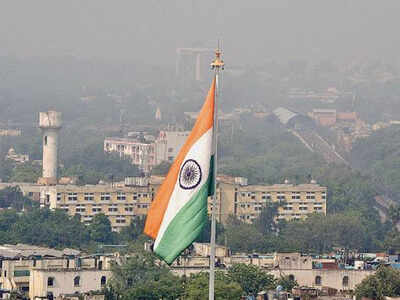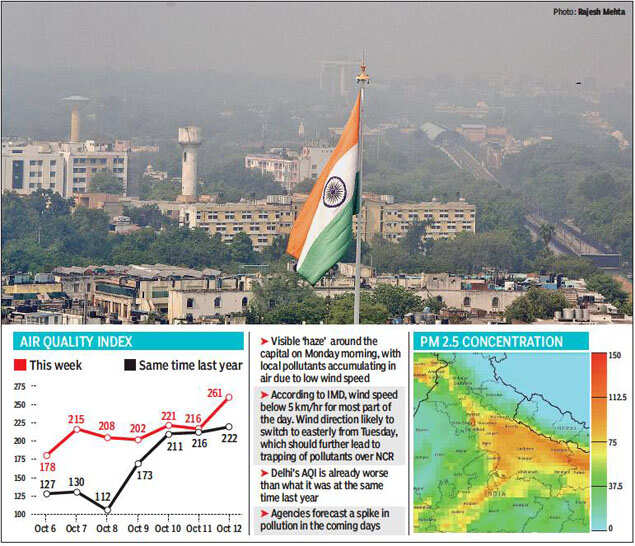
NEW DELHI: With a visible haze around the capital on Monday morning, Delhi’s air quality index (AQI) touched this season’s high at 261, but remained in the “poor” category, states Central Pollution Control Board’s (CPCB) daily bulletin.
Track the pollution level in your city
The AQI deteriorated from Sunday’s 216, also in the “poor” category, due to low wind speeds, which led to trapping of pollutants locally. According to India Meteorological Department (IMD), wind speeds remained below 5km/hr during the day while a change in wind direction to easterly is likely to cause another spike in the coming days.

System of Air Quality and Weather Forecasting and Research (Safar), a central forecast body, estimated the contribution of stubble burning to Delhi’s PM2.5 readings to around 3%, indicating the majority of pollution source was local.
“Though stubble fires were observed on Monday around Punjab, Haryana and its neighbouring regions, with Safar’s synergised fire count estimated at 614 on October 11, the count is nearly one-eighth of the peak values observed in the last two years,” stated Safar. The peak values occur only by the first week of November. “The impact is likely to be negligible for the next two days,” it added.
Kuldeep Srivastava, scientist at IMD and head of Regional Weather Forecasting Centre in Delhi, said, “Wind speed in the region was almost nil, which may trap pollutants locally. Wind directions, which were northwesterly, are also changing to easterly from Tuesday and this is also likely to lead to an accumulation of pollutants. In this transition phase, there could be a further spike in pollution as it can get trapped over Delhi-NCR.”
Nasa’s satellite imagery showed crop fires were more widespread across India and Pakistan on Monday, with a “hazy” sky recorded across the Indo-Gangetic plains. Pawan Gupta, a senior scientist at Universities Space Research Association of National Aeronautics and Space Administration who analysed the satellite data, said PM2.5 readings were spiking across the Indo-Gangetic plains.
“On October 11, there was high aerosol smoke detection via satellite, including over Delhi, which is now being recorded all the way to Indore,” said Gupta.
The CPCB data shows AQI is already worse than what it was at the same time last year. Last week, the Supreme Court-appointed Environment Pollution (Prevention and Control) Authority (EPCA) had announced implementation of certain measures under Graded Response Action Plan from October 15, including a ban on diesel generator sets in Delhi, Noida, Greater Noida, Ghaziabad, Faridabad and Gurgaon.
EPCA chairman Bhure Lal told TOI that EPCA might hold a review meeting if air quality touched “very poor”, an AQI between 301 and 400. “The CPCB-led task force may soon announce further measures,” he added.
Track the pollution level in your city
The AQI deteriorated from Sunday’s 216, also in the “poor” category, due to low wind speeds, which led to trapping of pollutants locally. According to India Meteorological Department (IMD), wind speeds remained below 5km/hr during the day while a change in wind direction to easterly is likely to cause another spike in the coming days.

System of Air Quality and Weather Forecasting and Research (Safar), a central forecast body, estimated the contribution of stubble burning to Delhi’s PM2.5 readings to around 3%, indicating the majority of pollution source was local.
“Though stubble fires were observed on Monday around Punjab, Haryana and its neighbouring regions, with Safar’s synergised fire count estimated at 614 on October 11, the count is nearly one-eighth of the peak values observed in the last two years,” stated Safar. The peak values occur only by the first week of November. “The impact is likely to be negligible for the next two days,” it added.
Kuldeep Srivastava, scientist at IMD and head of Regional Weather Forecasting Centre in Delhi, said, “Wind speed in the region was almost nil, which may trap pollutants locally. Wind directions, which were northwesterly, are also changing to easterly from Tuesday and this is also likely to lead to an accumulation of pollutants. In this transition phase, there could be a further spike in pollution as it can get trapped over Delhi-NCR.”
Nasa’s satellite imagery showed crop fires were more widespread across India and Pakistan on Monday, with a “hazy” sky recorded across the Indo-Gangetic plains. Pawan Gupta, a senior scientist at Universities Space Research Association of National Aeronautics and Space Administration who analysed the satellite data, said PM2.5 readings were spiking across the Indo-Gangetic plains.
“On October 11, there was high aerosol smoke detection via satellite, including over Delhi, which is now being recorded all the way to Indore,” said Gupta.
The CPCB data shows AQI is already worse than what it was at the same time last year. Last week, the Supreme Court-appointed Environment Pollution (Prevention and Control) Authority (EPCA) had announced implementation of certain measures under Graded Response Action Plan from October 15, including a ban on diesel generator sets in Delhi, Noida, Greater Noida, Ghaziabad, Faridabad and Gurgaon.
EPCA chairman Bhure Lal told TOI that EPCA might hold a review meeting if air quality touched “very poor”, an AQI between 301 and 400. “The CPCB-led task force may soon announce further measures,” he added.

Coronavirus outbreak
Trending Topics
LATEST VIDEOS
City
 Mumbai power outage: Fire in generator set at Apex Hospital; 1 dead
Mumbai power outage: Fire in generator set at Apex Hospital; 1 dead  Bengaluru riots: Crime Branch files chargesheet, names ex-Congress mayor Sampath Raj as accused
Bengaluru riots: Crime Branch files chargesheet, names ex-Congress mayor Sampath Raj as accused  Bihar polls: BJP expels nine party leaders who joined LJP
Bihar polls: BJP expels nine party leaders who joined LJP  Vizag locals in panic after reports of alleged gas leak from plant; officials confirm ‘no leakage’
Vizag locals in panic after reports of alleged gas leak from plant; officials confirm ‘no leakage’
More from TOI
Navbharat Times
Featured Today in Travel
Get the app





